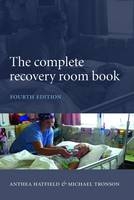
The Complete Recovery Room Book
Oxford University Press (Verlag)
978-0-19-923268-0 (ISBN)
- Titel ist leider vergriffen;
keine Neuauflage - Artikel merken
The care that a patient receives in the first hours after surgery is crucial to minimizing the risk of complications such as heart attacks, pneumonia, and blood clots. As the patient awakes from their drug-induced coma, it takes time for them to metabolize and excrete these drugs, during which period they remain unable to care for themselves, and at increased risk of harm. The body undergoes extreme physiological assault from pain, hypothermia, hypoxia, acid-base disturbance and shifts in blood volume. The recovery room staff must manage these symptoms in both comatose and physiologically unstable patients, and deal with the immediate post-operative care of surgical patients by attending to drips, drains and dressings. It is an environment where many skills and equipment are brought together, and successful development of these units has significantly reduced the number of deaths from preventable conditions. In helping the patient from the high pressure operating theatre to the wards, nurses, surgeons and anaesthetists will be required to manage day-to-day problems, but also make difficult decisions.Previous editions of this book have established it as the definitive guide to setting-up, equipping, staffing, and administering this acute care unit.
It includes basic science such as physiology and pharmacology, specific symptoms including pain and vomiting, and has chapters devoted to the unique post-operative needs of individual types of surgery. This new edition brings this important text up to date, including new material on risk management, administration and quality control; expanded sections on anaesthetic practice and infection prevention; and incorporating the recent developments in pain control, nausea and vomiting, care of children, pregnancy, and care of the cardiac patient.
Anthea Hatfield is an Honorary Life Member of the Pacific Island Society of Anaesthetists. Michael Tronson was previously Director of Anaesthesia at Prince Harry's Hospital, Melbourne, and Monash Medical Centre, Melbourne. He was previously a Senior Lecturer at Monash University, with over 20 years' experience in medical and paramedical training. He is an Honorary Life Member of the Pacific Island Society of Anaesthetists.
Golden rules ; 1. Recovery room routines ; 2. Recovery room procedures ; 3. Monitoring and equipment ; 4. Pain ; 5. Postoperative pain ; 6. Analgesics ; 7. Postoperative nausea and vomiting ; 8. Regional analgesia ; 9. Special problems ; 10. Pharmacology ; 11. Mothers and babies ; 12. Paediatrics ; 13. The elderly patient ; 14. Respiratory physiology ; 15. The respiratory system ; 16. Cardiovascular physiology ; 17. Cardiovascular disease ; 18. Cardiopulmonary resuscitation ; 19. Shock ; 20. Crisis management ; 21. The kidney ; 22. Fluid balance ; 23. Metabolism ; 24. Chronic disorders ; 25. The bleeding patient ; 26. Surgical issues ; 27. Infection control ; 28. Design of recovery room ; 29. Working with people ; 30. Working with facts ; Appendix 1: Trolley setups ; Appendix 2: Infusions ; Glossary ; Abbreviations ; Useful data
| Erscheint lt. Verlag | 27.11.2008 |
|---|---|
| Zusatzinfo | 83 black and white line illustrations |
| Verlagsort | Oxford |
| Sprache | englisch |
| Maße | 155 x 234 mm |
| Gewicht | 1014 g |
| Themenwelt | Medizin / Pharmazie ► Medizinische Fachgebiete ► Chirurgie |
| ISBN-10 | 0-19-923268-7 / 0199232687 |
| ISBN-13 | 978-0-19-923268-0 / 9780199232680 |
| Zustand | Neuware |
| Haben Sie eine Frage zum Produkt? |
aus dem Bereich


